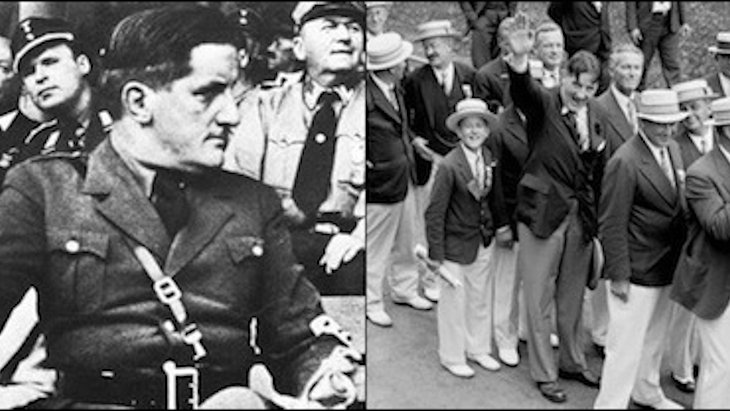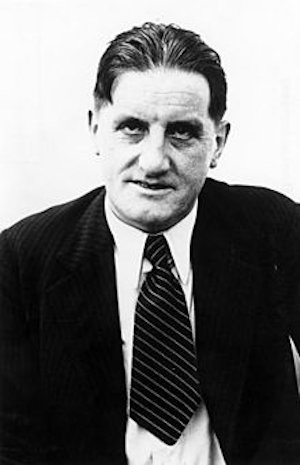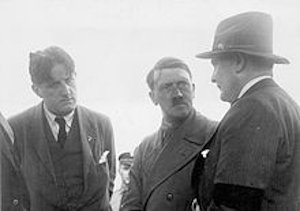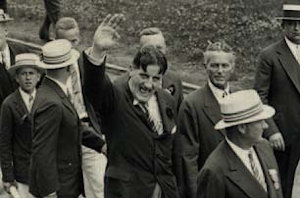 Passover’s Message of Hope in the Aftermath of Oct. 7
Passover’s Message of Hope in the Aftermath of Oct. 7


9 min read
Senior Nazi official Ernst Hansfstaengl attended his 25th Harvard reunion in 1934, despite his Nazi ties.
Ernst Hanfstaengl was a larger than life figure. Tall and regal, he had an aristocratic manner and was a talented musician. He charmed many of the people he came across, from future American President Franklin Delano Roosevelt to his many admiring classmates and professors at Harvard where he studied, to the man who eventually became his best friend and mentor: Adolf Hitler.
An ardent Nazi, Hanfstaengl tested the humanitarian resolve of his friends back at Harvard. After he was invited to be class marshal at Harvard’s 1934 Commencement exercises, Hanfstaengl became a divisive figure – inspiring some students to make gestures supporting the Nazis, and motivating many others to actively oppose him and the vile Nazi regime he represented.

Born into an upper class family in Munich in 1887, Hanfstaengl’s mother was American and when time came for him to go to college, he attended Harvard University. “In the early 1960s, we knew about this man,” recalled Jeffrey S. Mehlman, a member of the Harvard Class of 1965 who went on to become a professor of French Literature at Boston University. Hanfstaengl was known as a bonvivant and talented piano player (Wagner, the anti-Semitic German composer, was his particular favorite). He rowed crew, made friends widely, and even enjoyed personal invitations to the home of Harvard President Charles W. Eliot. He befriended Pres. Theodore Roosevelt’s son, who was also a student at Harvard, and spent Christmas of 1908 as a guest at the White House. “He was known as a good musician, and the big story was that Harvard was so powerful it had friends all over the world on all sides of every issue”, Mehlman remembered.
After graduating from Harvard in 1909, Hanfstaengl returned to Germany and kept up his Harvard connections. A member of Harvard’s Hasty Pudding Club introduced him to an American military attaché who told Hanfstaengl he’d just discovered “a most remarkable fellow” – a small-time would-be politician named Adolf Hitler.
Hanfstaengl went to a local beer hall where Hitler was speaking. He later recalled that with his “odd little mustache”, Hitler looked “like a waiter in a railway station restaurant” – but when the future mass murderer and dictator began to rant, Hanfstaengl was mesmerized. He visited Hitler’s home and played an upright piano he found there, quickly becoming noticed by Hitler and his inner circle. Hanfstaengl played a piece by Wagner and Hitler danced around, “waving his arms” he later described.
 With Hitler and Goring in 1932
With Hitler and Goring in 1932
The two men became close friends (some observers noted that they seemed to have an odd, sinister bond with each other), and Hanfstaengl tried to teach Hitler more about high culture to help him further his political aspirations. Hanfstaengl’s Harvard connections were particularly prized: one day he played some Harvard football marches on the piano, and Hitler cried, “’That is it, Hanfstaengl, that is what we need for the movement, marvelous,’ and he pranced up and down the room like a drum majorette,” Hanfstaengl later wrote.
He wrote more marches for Hitler and composed the infamous Sieg Heil! Sieg Heil! March, adapting a cheer he knew from his Harvard days that went “Harvard! Harvard! Harvard! Rah! Rah! Rah!”The march (which means “Hail Victory!” in German) was soon shouted every time Hitler spoke and became a hallmark of the Nazi party and its rallies.
By 1934, Hanfstaengl was in charge of the Nazi Party’s foreign press office. That was also the year of his 25th Harvard reunion. At Harvard, members of key reunion classes – 25th, 50th, and 75th – are invited to graduation, parade through the streets and through Harvard Yard, and sit on the stage while Harvard students receive their degrees. Hanfstaengl was invited by his classmates to help coordinate their parade, serving as Vice Marshal for the class of 1909 at the reunion. “He was an international celebrity, a good musician, and that was enough for his classmates,” explains Prof. Mehlman.
Some students were thrilled with the Nazi celebrity’s invitation – the young student editors at Harvard Crimson student paper even recommended that Hanfstaengl receive an honorary degree at the graduation ceremony. In an editorial titled “Render Unto Caesar”, students argued that because “he has risen to distinguished station” in a “country which happens to be a great world power,” an honorary degree was appropriate.
Harvard in the 1930s was a bastion of white male Christian privilege – very few Jews or other minorities could attend and discrimination was widely accepted. Still, even within the restrictive social mores of the era, the editors of the Harvard Crimson were reactionary, criticizing anti-Nazi organizations on campus and flirting with open approval of some Nazi policies.
Jewish and anti-Nazi groups were outraged, and soon Hanfstaengl’s planned visit was attracting widespread attention and protests. Amid all the uproar, Hanfstaengl rejected the offer of being Vice Marshal and said he wouldn’t attend. Then two days later he changed his mind and set sail for America and the graduation ceremony. By the time his ship docked in New York on June 16, 1935, a hostile crowd of 1,500 was waiting to confront him. Unwilling to brave the crowds, Hanfstaengl didn’t go ashore, and unceremoniously boarded a tugboat instead, which brought him to shore later on, a coward unwilling to face his critics head on.
Once in Cambridge, Massachusetts, Hanfstaengl was given a security detail. Several distinguished alumni invited Hanfstaengl to their homes – even Harvard University President James Bryant Conant invited him to his house for a tea party. (In his memoirs, Conant later maintained that he tried to make his disdain for his Nazi guest clear. When Hanfstaengl tried to make conversation, Conant recalled his manner was “cold; I did not return the greetings.”)
 Marching in the Harvard parade
Marching in the Harvard parade
All week long, Hanfstaengl courted attention, giving several press conferences and announcing that he was going to endow a scholarship to bring Harvard students to Germany and donate $1,000 to the university. During one press conference in Harvard Yard, Rabbi Joseph Solomon Shubow – who was a Harvard alumnus – confronted him, asking about the plight of German Jews under Nazism. When Hanfstaengl replied, “I will say that the Jews’ situation in Germany is going to be normal before long,” Rabbi Shubow asked him “Did you mean by extermination?” Before he could reply, a Harvard police officer grabbed Hanfstaengl’s arm and announced the interview was over. Hanfstaengl told the crowd that since he was on vacation he couldn’t talk about such matters, then he proceeded to President Conant’s house for tea.
The day before commencement, the university held a day of festivities called Class Day. With Hanfstaengl in attendance, the occasion had a decidedly Nazi flavor. Hansfstaengl entered the area where the ceremonies were taking place and gave a Nazi salute. Some students applauded and returned the gesture – a few members of the class of 1924, celebrating their tenth anniversary, even goose-stepped into Harvard Stadium and gave the Nazi salute. Students held up comic posters, some of which referenced Hitler and Nazis and made jokes about them.
The next day was commencement day, and it had a more somber tone. Many students and townspeople lined the streets of Cambridge, protesting the Nazi in their midst. Harvard’s commencement ceremony was disrupted by two Radcliffe undergraduates who chained themselves to benches in Harvard Yard and yelled “Down with Hanfstaengl!” and “Down with Hitler!” during President Conant’s speech. When police arrived to take them away, they threw off their coats to reveal bright red anti-Nazi slogans sewn onto their dresses. Nearby, in Harvard Square, a crowd of 2,000 noisily protested Hanfstaengl’s presence – among them Harvard and MIT undergraduates.
Police charged into the protestors and arrested several Harvard undergraduates. Seven Harvard students were even found guilty of disturbing the peace and were sentenced to six month’s hard labor – an extremely harsh sentence for protesting. Harvard President Conant strenuously lobbied for their release and six of the students were pardoned after a month in prison.
After his week reveling in attention in Cambridge, Hanfstaengl returned to Germany. “It has been the most enjoyable and successful vacation that I have had in years,” he declared. Back at Harvard, President Conant urged the overseers of the university to reject the proposed $1,000 scholarship. “Hitler’s henchmen (are) trying to use Harvard as an American base to spread approval of the Nazi regime,” he argued. The board members agreed, declaring: “We are unable to accept a gift from one who has so closely been associated with the leadership of a political party which has inflicted damage on the universities of Germany through measures which have struck at principles we believe to be fundamental to universities throughout the world.”
Hanfstaengl eventually fell out of favor with senior Nazis and fled to Switzerland then Britain in 1937. When World War II broke out, Britain classified him as an enemy alien and sent him to a detention center in Canada. From there, he managed to use his Harvard connections once again to get a letter to President Franklin Delano Roosevelt, offering to help the United States in the war in return for his freedom. Pres. Roosevelt agreed and had Hanfstaengl moved to a rural area outside Washington where he analyzed Nazi broadcasts and wrote memos about Nazi activities. He provided no useful information and American authorities eventually concluded that he couldn’t be trusted.
He returned to Germany after the end of the war and continued to keep up his Harvard connections. A 1959 article in the Harvard Crimson notes that Hanfstaengl was planning to return to the university for his class’s 50th reunion – and was planning to offer once again the $1,000 that the university refused to accept from him 25 years earlier. “But this time it will be different,” he told the student paper. “I expect to have a swell time, and get a warm welcome. Why not? I’m as anti-Nazi now as they come.”
Despite his protestations, Harvard again declined his offer.

Thank you for exposing the truth!
As I have always said - The Jewish people are the people the world loves to hate, UNTIL they need an invention, a cure or a donation!
It seems that Harvard has not learned anything by its previous mistakes on judging the character of people. Anti-semitism seems to be very present within the faculty of Harvard, if the just past president can’t condemn Hamas activities on Oct. 7th 2023!
I am not Jewish. I am an American Black, and I have always hated what was done to the Jewish People. The article was interesting. It makes you wonder how can so many people go wrong. Understand this you are so love by me.
Thank you for understanding!
Fascinating!